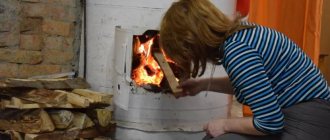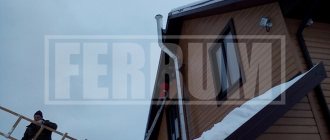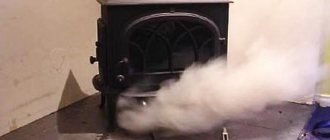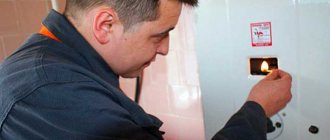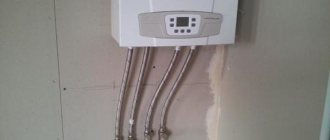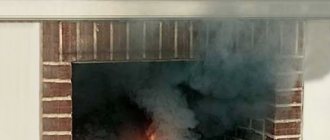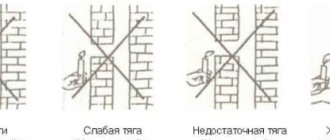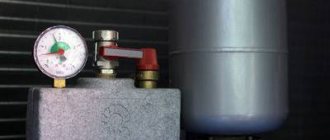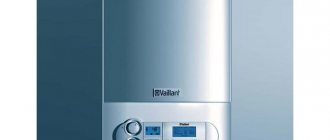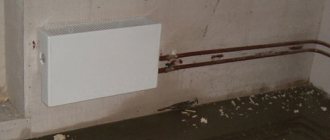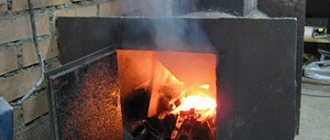- Construction changes
The article provides information about the causes of backdraft in a stove chimney, what to do about it, with video examples, as well as a guide to action. We will look at ways to stabilize the situation, ranging from making structural changes, continuing with the use of various devices, and ending with a review of ventilation. And, of course, we will share the secrets of prevention and inspection so that you are warned and armed, and your home is protected.
What it is
During normal operation of the smoke exhaust system, gas generated as a result of fuel combustion is discharged outside. If the operating mode is incorrect, you may observe the opposite situation. The smoke does not go straight up through the pipeline, as it should, but down, it does not go out into the street, instead it pours into the house - that’s what reverse draft is. And it is not just an unpleasant, but a truly dangerous phenomenon, which, if neglected, leads to a fire hazard in the house, or even to severe carbon monoxide poisoning.
Gradual heating of the boiler
If a gas heating system is used in country houses and has been inoperative for a long time, even weak gusts of wind can cause the flame to die out.
The problem is solved by gradually heating the boiler, namely, first after ignition, set the minimum temperature, after 5-10 minutes add gas, and after 20-30 minutes warm up the chimney at high settings. This will allow the chimney to fully warm up, which will make it easier for the exhaust gas to escape up the chimney.
Norms
Draft is the movement of smoke up the chimney from an area of high pressure to an area of low pressure. Gas by its nature tends to the zone of least resistance (in this case, up and out), with acceleration provided by the pipe, which acts as an aerodynamic corridor.
If the speed of movement is suitable, fuel combustion occurs as planned: harmful combustion products are promptly and completely removed outside, and a supply of fresh air is ensured. If excessive, the fire may be blown out by a sharp gust due to too much exhaust. If missing, the flame will simply go out.
Therefore, it is so important to maintain uninterrupted operation of the heating system, in particular, stable pressure in the boiler and in the hose area. The norm in this case is from 10 to 20 Pa, depending on the area and height of the premises, the number of rooms and number of floors, and the climatic zone in which the building is built.
What does the indicator depend on?
The average draft in a sauna stove is 10 Pascal. It is measured behind the smoke pipe, where the rate of smoke evacuation is clearly visible. In addition, here you can determine the correspondence of the dimensions of the firebox to the diametrical size of the chimney.
The traction force of the smoke and gas exhaust pipe is affected by:
- Chimney length. The minimum height is five meters. This size is sufficient to provide natural vacuum. The smoke begins to rise freely. The dependence of draft on the length of the chimney channel is proportional. Traction should be improved by increasing the height of the pipe.
- Temperature of the exiting smoke or gas. With increased heating, gaseous combustion products move upward at a higher speed. Traction increases.
- Duration of heating the chimney. The less time is spent, the faster the thrust reaches the norm.
- Roughness of the internal walls of the chimney. The higher, the worse the traction. It is advisable to provide a smooth surface.
- Section and shape of the chimney duct. The best option is a circle, oval, rectangle. More intricate designs result in less thrust.
- The ratio of the combustion device to the diameter of the pipe at the outlet of the chimney pipe. If the height of the chimney exceeds the maximum values, the cross-section should be reduced by 10%. You can use an adapter for this.
Chimney height
How to detect reverse draft in a chimney
Now one of the most modern ways to detect its presence (in non-obvious situations) is considered to be an anemometer test. This is an easy-to-use device, today it is not only mechanical, but also digital: just bring it to the inlet and outlet of the pipe, and it will show the current pressure. If its indicators are lower than the already mentioned 10-20 Pa, it’s time to sound the alarm. There is only one thing: this equipment will take readings only in the presence of a wind flow of more than 1 m/s.
What to do if such equipment is not at hand? Use traditional methods:
- Light a match, or better yet a candle, bring it to the heating unit and see how the fire behaves. If the tongue pulls into the channel, then everything is in order, but when it remains motionless, there is no air circulation; if it goes to the side, there is a problem.
- Visually, that is, see if the room is smoked - even the slightest signs of billowing steam indicate reverse draft. Although this is the most inaccurate way.
- If you bring the combustion mirror closer to a working furnace, it fogs up, which means the steam is not being fully released.
- Pay attention to the color of the flame when burning wood (peat, gas). If it is golden, everything is fine; when it is white, the extraction is too strong; if it is reddish or red, there is a return effect.
- Bring a tape, a paper sheet, a plastic bag to the firebox, holding it by the edge, and see where it moves. If it stays in place, there is no air circulation; if it moves away from you, the system works correctly; if it moves toward you, there is a problem.
Solutions if the boiler goes out in the wind
Changes in gas pressure do not occur very often. Moreover, the differences are so insignificant that they are unlikely to be the reason. Don't immediately look for a hardware problem. The design of the latest models of gas boilers is quite simple, but at the same time reliable.
The most commonly found deficiencies are:
- Formation of an ice clod that blocks the ventilation channel. It prevents the exchange of air particles that enables combustion. The appearance of ice is a natural phenomenon, because in addition to spent fuel, condensate penetrates into the pipes. It just freezes on the walls.
- Backdraft, which occurs due to strong and gusty winds, as well as during a sudden change in movement. It moves along the entire length of the structure and eventually reaches the boiler. The flame in it goes out.
Ice is an artificial obstacle, and its formation means that the structure was assembled incorrectly. To correct errors, you must immediately stop using the oven and contact a specialist. They will clean the pipe, install a condensate drain (umbrella, canopy) or a walk-through collector.
Backdraft is a great danger due to the extinguishing of the burner flame. The system in the latest generation boiler equipment is more modern. The automatic system quickly operates and stops supplying gas to the firebox. However, combustion products first enter the heating installation, thereby polluting the chamber. During subsequent switching on, they will penetrate inside. The reason for this phenomenon is most often the insufficient length of the chimney. To correct the situation you need:
- Structural changes.
- Installation of the stabilizer (thrust regulator).
- Installation of the deflector.
- Connection of (rotary) gate.
Why does backdraft occur in a stove or chimney?
Among the main reasons are the following:
- Incorrect design or installation of the chimney (height, cross-section of pipes, presence of horizontal sections).
- The presence of a nearby tall object (tree or building).
- Violation of ventilation.
- Excessive soot emission and chimney blockage.
All the reasons for its appearance are conditionally divided into two groups:
- Simple - when it is only a temporary problem. The stove was not working for a long time or the weather was cold outside.
- Complex – complex, permanent, global, to get rid of which you need to take important steps. This includes errors in design or ventilation, high objects near a residential building, and clogged chimneys.
Let's consider each of them with the obligatory mention of the degree of its seriousness.
Problems with the design
This is the case when errors were made at the design stage and affect the operation of the equipped heating system. Among the main mistakes:
- Incorrect calculation of the diameter (cross section) of the pipe, due to which the channel for the exit of combustion products is too narrow.
- A large number of horizontal (or inclined, but located at a small angle) sections in the hose, due to which the gas comes out too slowly.
- Insufficient volume of the combustion chamber, due to which harmful combustion products do not have time to completely leave the room. Height.
This is a complex problem that can only be solved through modification and restructuring.
Incorrect installation of the heating device
From time to time a situation arises when the design documentation was drawn up correctly, but mistakes were made by those who installed the equipment. Do-it-yourself assembly is fraught with the following errors:
- Pipes of different sections are used.
- Not all joints are sealed.
- Gaps remain.
- The boiler is not fastened well.
Failure to comply with basic standards when installing a chimney leads to backdraft.
The work often becomes an explanation of why there is backdraft in the chimney, and a simple conclusion can be drawn. Only experienced professionals should be involved in arranging a heating system for a private home, so that later you don’t have to redo it, spend money, or risk your health.
Selection of materials
This point is also key, because if the inner surface of the pipe is rough, steam particles will be retained and go back. If you choose metal with low corrosion resistance, it will rust, which will also worsen the circulation of air masses.
We are no longer talking about the fact that ceramics, brick, stainless steel differ from each other in terms of thermal conductivity and sealing, which means that in the channel made from each of them there will be different pressures. This is a point that must be taken into account when designing, so that later you do not have to make difficult decisions and change or redo part of the heating system.
Ferrum steel smoke exhaust systems meet all technical requirements. On the website feflues.ru you can select a ready-made kit with a quality guarantee from the manufacturer, and also check the price list.
Chimney blockage
A clogged pipe is a common reason why the chimney blows in the opposite direction. The draft deteriorates significantly or stops altogether if a lot of soot and soot settles on the walls, as a result of which the sleeve becomes too narrow or “zero”. When does this happen? Again, when constructing a channel from a material that is not smooth enough, with roughness that literally attracts various contaminants.
In the most advanced cases, even mechanical debris trapped inside prevents the timely removal of combustion products. But this is not the most insoluble problem, the consequences of which can be minimized by regular prevention or prevented at the design stage by choosing a modular design made of stainless steel.
Chimney height
This reason includes several different but common cases:
- the ridge of the roof is located above the level of the chimney, and during heavy gusts of air flow, a “overturning” is observed, that is, the smoke begins to sharply flow into the room;
- taller buildings and structures are located nearby, forming the so-called wind support;
- There are large trees nearby, from which smoke can also be reflected and return to the chimney.
The problem of tall trees or tall buildings standing nearby is not always possible to solve. In this case, an option is offered to make the structure yourself - a cap with a branch. You can make this cap yourself by looking at information and video reviews on the Internet.
Violation of natural ventilation
Difficulties arise in the absence of air flow, when oxygen becomes less and less (burns out), in order to continue combustion, the pipe “sucks” it from the street. If, due to improper design and/or construction, there are drafts in the room, this changes the movement of flows, under the influence of one of which the gas from the furnace may flow not upward, but to the side.
Our production
Single wall chimneys
Double wall chimneys
Mounting elements
Okay, do you know the reasons for backdraft in the furnace, and what to do if, as a result of the appearance and development of any of them, the chimney blows in the wrong direction? It is necessary to stabilize the exhaust gas output, and this can be achieved in almost every situation. Yes, in some places you will have to spend more, in others less, but most cases can be corrected even on your own, without inviting specialists. Below we will tell you what to do and what to do.
Pipe cleaning
Work should begin with cleaning the chimney. All doors in the stove and smoke ducts must be tightly closed and secured. If a large amount of soot falls from a height of 3-4 m, dust may be released into the house. A special brush is used for cleaning; if you don’t have a ready-made one, you can do it yourself. The device will require a strong rope or cable. At one end you should attach a weight weighing 2-3 kg and a pair of old hard washcloths. You can use a fluffy ball of wire, stiff cord, or something similar. The fastening must be strong; parts that come off and get stuck in the pipe can cause a lot of problems.
You need to climb onto the roof with the brush, lower it into the pipe, pull it up and down several times, if possible, rotating and swinging it to the sides. Similar work needs to be done to understand why the fireplace is smoking. If after cleaning the operation stabilizes, the problem is solved. Otherwise, you need to look further.
Ways to normalize cravings
This includes methods for enhancing low steam output and preventing tip-over. Depending on the state of affairs, you can use either one or several of them at once.
Construction changes
If the problem is due to incorrect design or unskilled installation, the defects must be corrected. The most common things you need to do are:
- Increase the height of the pipe (if it is small) so that its top is at least 0.5 m above the roof level. And this is for a separate building. For a house located close to trees or adjacent to other real estate, this figure is already 1.5 m.
- Expand the channel - when you don’t know how to deal with backdraft, simply increase the cross-sectional width of the chimney so that it is no less than that of the boiler pipe. Then the air masses will circulate more actively.
- Remove too long (longer than 1 m) horizontal sections of the sleeve, replacing them with inclined sections running at an angle of 30°, get rid of 90° turns in favor of 45° transitions.
Using a regulator (stabilizer)
The configuration of the smoke exhaust system largely depends on the type of heat-generating apparatus with which it is planned to be used. Efficiency is affected by natural temperature fluctuations - time of year and weather. In cold weather, significant temperature changes can lead to high vacuum in the chimney. And this will lead to decreased operating efficiency and increased fuel consumption. The regulator stabilizes the pressure to the optimal value and thereby increases the efficiency of the heating device.
Air pressure can also cause back draft in the chimney. It is determined by location (in the mountains, for example, lower than at sea level) and time of day, weather conditions, season - in summer, air pressure is higher than in winter. Thus, the difference between air pressure on a cloudy April day and a clear day in September can be up to 90 Pa.
Deflectors
These are simple but effective devices that deflect air flows that are reflected by trees, walls of neighboring buildings (and other tall objects), and thus prevent the exhaust gases that escape from reentering the pipe. They help to normalize (usually reduce) pressure and increase the aerodynamic effect, and are easy to install. They give results even in strong winds, but in calm conditions they are practically useless, and this is their main disadvantage.
Ferrum produces both a windproof and a regular umbrella, which will also help cope with precipitation and wind, and prevent the draft from tipping over.
Weather vane deflector device
This is a kind of hybrid of two devices, taking the best from a reflector and an air flow amplifier.
Consists of 3 components:
- the lower cylinder is a pipe that, after assembly, is in direct contact with the chimney;
- the upper glass with racks as a structure - catches and changes the direction of movement of the reflected gas masses;
- cap (umbrella) - can be flat, semicircular, conical, protects the channel from debris and precipitation.
Installing a weather vane deflector is the answer to two questions at once: how to eliminate backdraft in a chimney when there is wind pressure and how to increase the normal draft by 15-20%. Its installation is not difficult: just drill holes in the pipe and secure the device with screws. To prevent it from dangling, you can lay a clamp. It can be really securely fixed even on brickwork - with the help of adapters.
Stainless steel rotary gate device
A mechanical regulator, most in demand when arranging steel channels for the removal of harmful combustion products. It is a section of pipe through the center of which a valve passes, partially blocking the chimney.
It is very simple to use: turn the axis, slightly open the valve, and release steam, reduce the gap, and the gas exit speed decreases.
Gate and valve made of stainless steel
Advantages:
- high anti-corrosion properties;
- smooth surface that does not collect soot;
- light weight with the strength of even a thin plate;
- variety of handles and flaps;
- Possibility of installation in both steel and brick channels.
Cast iron gate
Its design and operating principle are the same as the rotary one. The difference is in the raw material: it is made of metal that is susceptible to corrosion. Therefore, if you are thinking about how to remove back draft in a chimney and get rid of it mechanically, you can give preference to this regulator. Just keep in mind that it will be heavy, which means it will only be suitable for a channel that can withstand significant weight loads. In general, the material is considered obsolete, so if you have a choice, you should pay attention to a stainless steel sample.
Rotary turbines
With the installation of one of them - a hybrid of a deflector and a weather vane - you will also stop thinking about how to avoid backdraft in the chimney, because excess gas will be discharged automatically.
The device is a nozzle equipped with steam speed and temperature sensors and, most importantly, an electrically driven screw that forcibly pushes combustion products out. A convenient solution for those cases when it is impossible to arrange a channel of sufficient height.
Revision of the ventilation system
It is necessary to analyze how it is organized, eliminate errors and take measures to eliminate drafts and streamline the masses circulating in the room. It usually comes down to the following steps:
- regular ventilation of rooms (especially those where heating equipment operates);
- installation of window and wall supply valves - to constantly obtain fresh air;
- installation of forced ventilation devices - if previous measures do not help.
Timely cleaning
This is also an effective measure to improve the removal of gases. It is important to regularly remove soot that settles in the channel, because otherwise the soot will make even the smoothest walls rough. You need to pull out any debris that gets into the sleeve and clogs or even tightly clogs it.
Increasing the height of the smoke channel
This is the easiest option to increase the traction force in the smoke exhaust duct. Light doesn't mean cheap. It all depends on the high cost of the materials used in the construction of the chimney. The addition of pipe height must be calculated from the existing limits. The maximum permissible extension of the chimney is 4-5 m to the grate.
It is important to note that it is not recommended to deviate the direction of the enlarged section of the pipe, since in this case the traction force will decrease even more.
For this reason, the smoke channel is enlarged in a strictly vertical position.
What are the dangers of improper operation of the heating system?
Now that the causes of backdraft in a chimney or boiler and their elimination are clear, let's see what happens if the problem is ignored.
If nothing is done, combustion products will accumulate in the pipe, which will then return to the living quarters. They are dangerous because they contain carbon monoxide, which can cause poisoning or even death. Anyone who does not want to correct problems risks the health of themselves and their loved ones.
It should also be noted that the efficiency of the equipment decreases, and therefore the cost of heating the house increases. This, of course, is not a threat to life, but it is a moment that punches a hole in the budget, that is, it cannot be neglected either.
Selection of devices for regulation
Let's consider some characteristic features and methods of using devices for monitoring and adjusting traction.
Deflectors
Such structures are installed on the chimney (at its very top) to create obstacles to air flow. The intensity of the wind force drops noticeably when encountering such devices placed on a pipe. The smoke escapes through the channel “to freedom” due to weak air currents entering the pipe. These flows “catch” the exhaust gases and “push” them out.
Deflectors eliminate the possibility of pipe clogging, and, if made with taste, they significantly improve the appearance of the entire building.
There are several types of deflectors:
- TsAGI;
- round Wolpert;
- Grigorovich;
- plate-shaped;
- in the form of the letter H;
- rotating;
- vane.
Almost all of these devices are made from stainless steel, in rare situations - from copper. Using brackets, clamps, bolts, sealing tape, the deflector is attached to the chimney pipe. Some devices are also equipped with additional functions: to extinguish sparks (to eliminate a possible fire in the roof), to control the temperature of the exhaust air (in this case, the sensor is triggered if hot air does not come out and there is a possibility of reverse draft).
The disadvantages of using deflectors are their minimal effectiveness in calm weather.
Photo gallery: types of deflectors
The most common device for improving traction
Such a device can be purchased in specialized stores
The choice of device depends on the design features of the pipes and your preferences
Rotary devices
Turbines installed at the head of the chimney use the energy capabilities of the wind. Air flows set the rotary nozzle in motion (it always moves in one direction), and thereby the air becomes rarefied near the chimney. The entry of any foreign objects and sediment into the chimney with a rotary pipe is completely excluded.
Rotary pipes have a big disadvantage, similar to the operation of a deflector. Their use on a windless day is ineffective.
If you do not have great abilities, buying such devices is not a problem.
Traction regulators
Such devices are a real find for residents of country houses, lovers of baths and fireplace gatherings. These devices are attached to the boiler chimney. They are equipped with a metal plate with a weight that balances it on one side. When the draft is good, the metal plate does not interfere with the free access of air into the chimney. With weak or reverse thrust, the metal plate serves as a kind of stupor.
The range limits for thrust are set by the consumer himself, the usual parameters are 10–35 Pa.
The device operates completely autonomously and does not require any electrical current.
Temporary backdraft
This is not a permanent problem, but a one-time or periodic one, manifesting itself within a short period of time, literally a few days. In practice, it most often occurs after prolonged bad weather (with dense fog, constant downpours, snowfall) or prolonged downtime of the heating system.
It can be explained simply by the formation of a plug of cold air in the pipe. It can also be easily eliminated - by burning several sheets of paper. This way you will warm up the channel and break through the barrier. It’s even better to install a stabilizer - it will help normalize the pressure in the sleeve.
Solution options
The main problem with blowing out the boiler is described in two words: reverse draft (also known as the action of the wind). If the burner constantly goes out on windy days, first of all you need to call specialists who will check the condition of the ventilation system and chimney. Only in accordance with their recommendations can you get down to business and eliminate the factors that cause the boiler to blow out.
Read also: Ranks in cs go in order 2022
Increase the height of the chimney pipe
The draft may be reduced if there are other high-rise buildings or tall trees near the building, which create an air “pocket” above the chimney. The turbulence of the wind flows in it blows out the boiler and causes the heating system to shut down.
If you raise the pipe higher, the draft will increase, and there will be no problems with the operation of the device. It is recommended to position the chimney so that its upper part is located 30 cm above the top point of the roof of the house.
High tube for increased traction
Prevention and testing methods
We told you why there is backdraft in the stove and what to do to eliminate it, and now we want to share the secret of how to prevent its occurrence. There is no secret in this, you just need:
- clean the chimney in a timely manner;
- regularly heat the system so that it does not stand idle;
- eliminate sources of drafts in residential premises;
- monitor the condition of devices installed on the pipe.
We have already described the testing methods in the section on identifying the problem, so here we will mention cases in which it is worth carrying out tests with a candle, paper or an anemometer. This should be done when the house has not been heated for a long time, there is (or has recently been) bad weather outside - heavy rain, blizzard, gusty wind, thick fog - and you want, for example, to light a fireplace. This is also true if the rooms, despite the kindling, are cold, or you suspect a malfunction.
And as a conclusion to the review of backdraft in the chimney and what to do when it appears, we offer a video - watch a useful video on this topic:
Stabilizer installation
The chimney draft stabilizer involves the installation of an additional structure in which a gas boiler draft sensor is built-in. To install the system, a so-called umbrella is installed on the chimney pipe. Between the open part of the hood and the smoke outlet pipe there is free space through which air flows freely pass.
The stabilizer is endowed with a specific design, which acts as a chimney draft regulator.
With its help, the stability of the air flow is monitored to determine the desired level of traction force in the chimney pipe. If necessary, a special gas boiler draft sensor is installed in the cap on the chimney pipe. He monitors the temperature inside the chimney. The sensor is triggered when the temperature of the gases rising through the pipe decreases.
Turbocharged boilers
When a turbocharged boiler is operating, combustion products are removed and air is forced into the furnace. Therefore, problems with traction occur less frequently, although they are not excluded.
Backdraft
When installing the boiler, it is very important to remove the coaxial chimney pipe from the leeward side of the building. This will prevent the formation of reverse draft. However, the wind direction may change, so it is advisable to take protective measures. After consulting with specialists, you can take the following measures:
- install a “fungus” on the end of the chimney;
- install a device to break the draft; this device is mounted in the internal channel of the coaxial chimney.
Naledi formation
Freezing of condensate in the pipe can become a serious problem. Ice formation often occurs during strong winds. To solve this problem, the chimney should be well insulated. In this case, ice will form on the outside of the chimney, and not on the inside. And external ice cannot affect the operation of the boiler, in addition, it will be easier to remove.
If the owners notice that their gas boiler blows out in a strong wind, then it is necessary to take protective measures. But before you do anything, you need to contact a specialist to identify the cause of the problem. And only then can you find the optimal way out of the situation.
Causes of turbocharged equipment failures
The device, which is equipped with a turbine inside, is considered the most stable during operation. The following systems are built into these boilers:
- pressure regulation;
- forced removal of spent fuel to the outside.
Even despite their main advantage - uninterrupted operation, they can go astray from the standard mode. A built-in draft sensor will signal a failure in the heating system. Interruptions indicate that the installation was performed incorrectly. Once again, make sure that the correct equipment is selected for your home.
The instructions included with the sale describe in detail the criteria for installation. First, it is recommended to ensure regular ventilation of the room. If the assembly location is chosen incorrectly or the wind direction often changes in the area of the house, then the failure can be easily corrected with your own hands. Determining the root cause, as well as ways to solve the problem, are considered on the same principle as in the case of atmospheric devices.
In fact, there are many problems associated with heating in private homes. Even modern equipment can sometimes let owners down. However, this is not a reason to refuse such a convenient, modern and, at the same time, profitable heating system. Additionally, it is recommended to study the video why a gas floor-standing boiler blows out in the wind.
